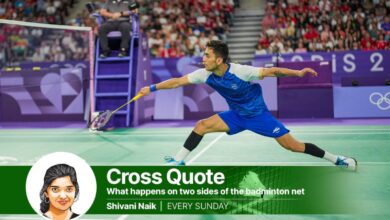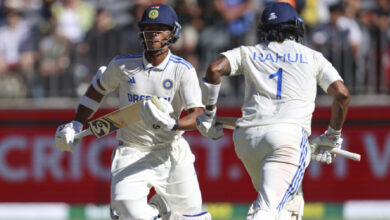The return of the drop shot: Alcaraz and Jabeur’s tennis mike-drop moments

French Open: Midway through her fourth-round beatdown of Bernarda Pera at the French Open on Monday, Ons Jabeur indulged in the pattern of play that has become something of her signature on tour.
Pera, under pressure down breakpoint at 0-3 in the opening set, used her lefty serve with venom to send Jabeur trailing behind the baseline for her backhand return, and then sent a powerful first-strike backhand crosscourt. Jabeur arched a single-handed backhand as if to go for a deep slice, but abruptly stopped her motion to hit a willowy drop shot – perfectly disguised and timed, landing just over the net into the opposite court. Pera did not bother chasing.
Carlos Alcaraz was midway through a similar demolition of Lorenzo Musetti in his fourth round on Sunday when he went for virtually the same pattern. Deep serve returned, backhand crosscourt, inch-perfect backhand drop shot, point won.
Both Jabeur and Alcaraz have been some of the best, most consent players on tour over the past year with a varied arsenal and a dynamic game. But their effective use of the drop shot in particular has turned heads in tennis circles, and led to hefty additions to their highlight-reels.
In the modern era, with bigger racquet frames, durable high-tension polyester strings, and greater emphasis on athleticism, the drop shot has fallen out of favour as a genuine tennis weapon. If baseline bashing is to be the most rewarding pattern of play, the drop shot is not much more than an exhausted Hail-Mary, or a ploy to end rallies sooner.
The shot’s popularity decreased in general, but even more so on the sluggish red clay, where the slow and slippery surface allows the ball to bounce higher, and opponents to slide, making them easier to retrieve. But Jabeur and Alcaraz, both of whose best surface is clay, have led a resurrection of sorts, taking the drop from a mere panic shot to an essential part of an elite player’s arsenal.
Sign you hit a good drop shot 👇#RolandGarros | Crina Bucsa pic.twitter.com/jmeLostk43
— Roland-Garros (@rolandgarros) May 30, 2023
Different styles
Alcaraz’s strengths give him greater breathing space for execution. Equipped with incredible firepower, and a topspin-laden forehand that can push opponents further and further behind the baseline, he is able to create just enough space between the net and the player to fox them going toe-to-toe with them from the baseline and then abruptly changing the rhythm making them chase a dropper at the net. His use of the continental grip also allows him to disguise his signature forehand drop shot perfectly.
It’s as much of a physical challenge chasing drop shots around the court as it is a mental challenge. There is a growing trend in men’s tennis of players standing far beyond the baseline to return serve. It allows them to neutralise strong serves and bring their stronger wing into play early for the baseline exchanges. Noticing the trend, many players have mixed up their game to exploit that return positioning. Chief among them is Alcaraz, who regularly serves and volleys, and goes for lower percentage shots like the drop, just to keep his opponents rethinking their tactics.
Jabeur, on the other hand, does not have other strengths that could aid her drop shot as much as Alcaraz. Variation is the defining aspect of her game, that doesn’t have obvious weapons of power or serve. Instead, she mixes things up using her groundstrokes to work the angles and keep her opponents moving side-to-side, before finishing things off with a feathery drop shot or coming to the net.
Jabeur’s ability to produce drop shots from almost any position of the court, without the firepower to send them well beyond the baseline, requires a more delicate touch, and commendable sleight of hand.
“I thought my dropshot was good, and then there’s Ons,” 2019 US Open champion Bianca Andreescu told press last week. “I think they (Alcaraz and Jabeur) do it at very good times, and they disguise it very well. I think those are the two keys to hitting great dropshots. But honestly, I think Ons has the best dropshot, like out of male and female players, Ons is number one.”
Numbers talk
To say that either player has started a drop shot revolution on tour would be premature. Novak Djokovic, for instance, has infamously persed in throwing in drops into long rallies, even if the timing is off, just to disrupt opponents’ rhythm.
But as Andreescu’s words suggest, Alcaraz and Jabeur’s mastery of the drop shot is undoubtedly rubbing off on the rest of the tour. Jabeur’s third round match against Olga Danilovic produced a women’s singles tournament-record 29 drop shots in total. During Alcaraz’s encounter against Musetti, both attempted 23 each. The key difference, though, was that only two of Musetti’s attempts were successful, as opposed to Alcaraz’s 18.
While styles and tactics differ, there is a commonality between Jabeur and Alcaraz’s approach – that drops are not just means for an abrupt winner or disruption of rhythm, but instead can help in point construction and setting up winners, a trait most treasured on slow clay. Of Alcaraz’s 18 successful drop shots against Musetti, only 7 resulted in winners, the rally continuing on the rest. The points went on for 10 of Jabeur’s 14 succesful drop shots against Pera too.
Given his Spanish roots, Alcaraz, who turned 20 last month, has long been considered the heir incumbent to Rafael Nadal’s clay throne. Nadal was the greatest proponent of the style of play that made drop shots obsolete on clay, with his reliance on spin, power, and athleticism. Alcaraz is bringing it back.
In just four matches at the French Open, Alcaraz has already made more successful drop shots (30), than Nadal made during his entire run to the title last year. The rally continued on none of Nadal’s successful drops – each of them were winners – showing how conservatively he used the strategy, only as a ploy to win a quick point.
While announcing his withdrawal from the tournament this year at a press conference, Nadal said: “Tournaments stay forever, players play and leave. Roland Garros will always be with us without me. It will be the best clay tournament in the world. There will be a new French Open champion, it is not going to be me.” If the torch is to be passed to Alcaraz, and that is a big if, he will surely be going about his business in an entirely different way. The drop shot then, is Alcaraz’s tennis mike-drop moment.







